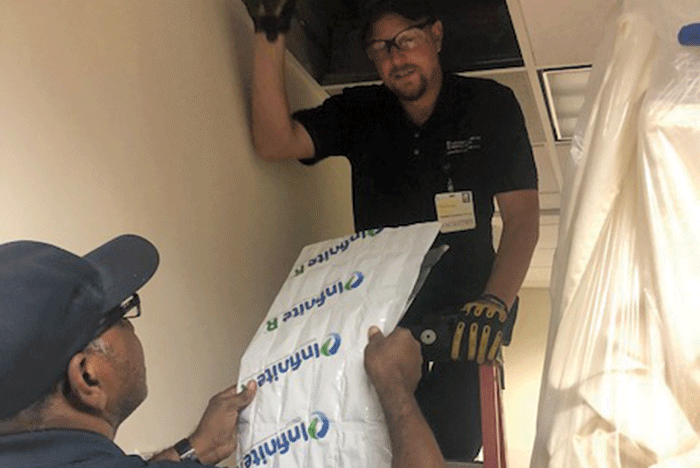Using PCM to improve patient comfort

Facility employees Darrell Bryant (left) and Ryan Katrinak pass Insolcorp PCM for installation.
Image courtesy of Richie Stever
The University of Maryland Marlene and Stewart Greenebaum Comprehensive Cancer Center (UMGCCC) in Baltimore provides outpatient care for cancer patients in a 25,000-square-foot, state-of-the-art facility named the Roslyn and Leonard Stoler Pavilion. The infusion/chemotherapy treatment portion of the Stoler Pavilion is a 7,500-square-foot extension of the main lobby of the University of Maryland Medical Center (UMMC), with large floor to ceiling storefront windows, 10-foot ceilings and a metal pan deck that is 10 feet above the uninsulated drop ceiling. When built, the facility’s HVAC system consisted of digitally controlled variable air volume boxes with reheat coils and baseboard heat.
The cancer patients in the infusion area wear thin gowns and sit next to the perimeter windows for eight to 10 hours a day, and some receive treatment multiple times a week. For years, the facilities staff received hot calls in the summer and cold calls in the winter.
The facilities staff tried a number of strategies to try and improve the building’s comfort. Staff would adjust the discharge temperature of the central air handlers to push colder air to the space, adjust the setpoints of the space, and even close dampers elsewhere on the floor to push more volume to the space. No matter what adjustments they made to the heating and air conditioning system, the patients, staff and visitors were never satisfied.
In the summer of 2018, the UMMC Director of Operations and Maintenance Richie Stever, CHFM, LEED AP, learned about phase change material (PCM) heat storage at the Better Buildings Summit in Cleveland.
Stever explains that there are two main types of thermal energy storage: sensible heat storage and latent heat storage. Sensible heat storage is the most common method for storing heat, which heats the material such as water, rock and soil to the stored temperature. Latent heat storage, however, stores energy through the phase transition from liquid-solid and/or solid-solid using water/ice, salt hydrates, paraffin or polyalcohol. PCM uses latent heat storage, and it essentially absorbs (melts) or releases (freezes) large amounts of latent heat when it changes physical state at a given temperature.
After learning about PCM, UMMC decided to try Albemarle, N.C.-based manufacturer Insolcorp’s PCM Mat to address the temperature swings experienced in the Stoler Pavilion. This material was chosen because it was nontoxic, Class A plenum fire rated and stored 100 British thermal units per square foot.
After discussing the application with the Insolcorp staff, the appropriate material was 2 feet by 4 feet sheets of 71-degree material that would simply be laid on top of the ceiling tiles over approximately 70% of the space.
One hundred percent coverage was not possible given the number of sprinkler heads, speakers, lights and diffusers that were already in the ceiling. The direction was to install the PCM Mats, ensuring that the ceiling’s mains and tees and not just its tile supported the material. After all, each sheet of PCM weighs approximately 8 pounds.
The temperature above and below the ceiling in two separate locations of the Stoler Pavilion were recorded for two weeks prior to the installation in order to prove the efficacy of the material. On Oct. 8, 2018, 10 UMMC facilities team members installed the material in two and a half hours. Prior to the installation, the UMMC facilities team received an average of 2.58 hot/cold calls per month from the Stoler Pavilion. Since the installation, the hot/cold calls have been reduced to zero.
The installation was focused on patient and staff satisfaction, so energy use wasn’t recorded, but Stever says the material should also help to reduce electricity costs per month.




